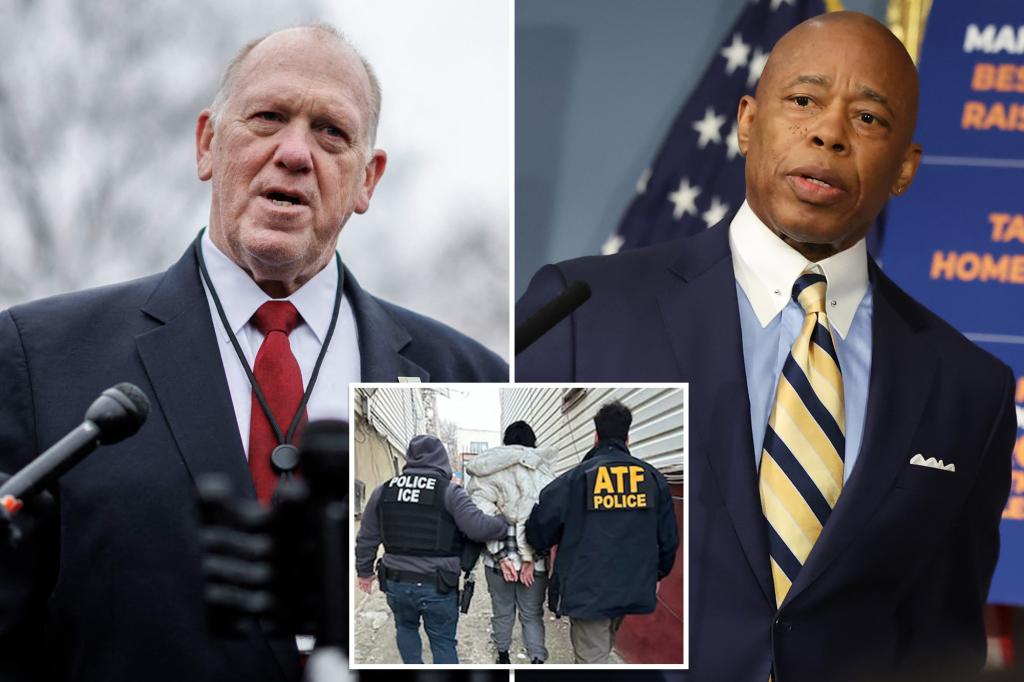World
Border czar Tom Homan says he’s meeting with Eric Adams Thursday – will try to hammer out agreement on arresting, deporting illegal migrants

The Upcoming Meeting Between Tom Homan and Eric Adams: A Push for Cooperation on Immigration Enforcement
President Trump’s border czar, Tom Homan, is set to meet with New York City Mayor Eric Adams to discuss a potential collaboration aimed at deporting illegal criminal migrants. This meeting is part of a broader effort by the Trump administration to address the presence of criminal migrants in the city, particularly those associated with gangs like Tren de Aragua. Homan, a former acting head of Immigration and Customs Enforcement (ICE), has been a vocal advocate for stricter immigration enforcement. He has expressed optimism about Adams’ willingness to cooperate, citing their previous meeting in December, where Adams showed interest in working together to tackle public safety threats and locate unaccounted migrant children.
Background: A Partnership in the Making
Homan and Adams have a history of dialogue on immigration issues. Their December meeting highlighted Adams’ openness to collaborating on deporting criminal migrants and addressing the humanitarian challenges posed by the migrant crisis. Adams’ administration has already taken significant steps in managing the influx of migrants, providing shelter to over 230,000 individuals since 2022. Despite these efforts, the mayor has been clear about the need for federal support, criticizing the previous administration for leaving the city to bear the financial burden of the crisis alone. Homan sees this as an opportunity to forge a partnership, emphasizing the mutual goal of ensuring public safety.
Homan’s Aims: NYPD Collaboration and Targeting Criminal Migrants
Homan’s primary objective is to secure the NYPD’s cooperation in identifying and deporting criminal migrants, particularly those linked to dangerous groups like Tren de Aragua. He hopes that Adams will agree to allow NYPD officers to work with federal agents to locate and apprehend these individuals. Homan acknowledges the challenges of operating in sanctuary cities, where local authorities often limit cooperation with federal immigration authorities. He argues that without such cooperation, the process of arresting and deporting criminal migrants becomes far more resource-intensive and complicated.
Legal Developments: DOJ’s Decision and Potential Implications
The Justice Department’s recent decision to drop a federal bribery case against Adams has introduced a new layer of complexity to the situation. While the mayor’s office has denied any suggestion that Adams is now indebted to Trump, critics like Rev. Al Sharpton have raised concerns that the dismissal of the case could exert pressure on Adams to comply with Trump’s agenda. The DOJ’s letter indicates that the case could be revisited after the 2025 mayoral election, leaving the door open for future legal challenges. This has sparked speculation about the motivations behind the DOJ’s decision and its potential impact on the city’s immigration policies.
Adams’ Stance: Consistency Amidst the Controversy
Mayor Adams’ press secretary, Kayla Mamelak, has emphasized that Adams’ position on criminal migrants has remained consistent. She highlighted the city’s efforts to shelter migrants while also stressing the need to address public safety concerns. According to Mamelak, Adams has been clear about his desire to work with the federal government to deport violent offenders after they have served their sentences. The mayor’s office has dismissed suggestions that the recent DOJ decision has influenced his stance, arguing that his commitment to public safety and cooperation with federal authorities has been unwavering since he took office.
The Broader Context: Sanctuary Cities and the Challenges of Immigration Enforcement
Homan has long been critical of sanctuary cities, arguing that they create an environment where criminal migrants can evade law enforcement. He points to the difficulty of apprehending these individuals without the cooperation of local authorities, noting that ICE agents face significant obstacles when trying to track down criminals in jurisdictions that limit collaboration. Homan estimates that there are over 600,000 illegal aliens with criminal histories currently in the U.S., underscoring the scale of the challenge. He believes that partnerships with local law enforcement are essential to addressing this issue effectively and ensuring public safety.
Conclusion: A High-Stakes Meeting with Far-Reaching Implications
The upcoming meeting between Homan and Adams represents a critical moment in the ongoing debate over immigration enforcement and sanctuary cities. While Homan is hopeful about reaching an agreement, the broader political and legal dynamics surrounding the issue add complexity to the situation. The outcomes of this meeting could have significant implications for New York City’s approach to handling criminal migrants, as well as the relationship between local and federal authorities in addressing immigration challenges. As the stakes continue to rise, all eyes will be on whether Adams and Homan can find common ground and pave the way for a more cooperative future.











